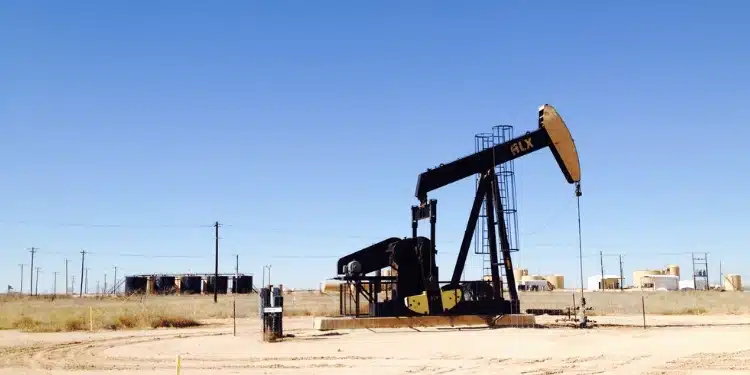Breaking: Gulf Stock Markets Face Historic Decline as Double Economic Blow Hits Region
Twin Economic Shocks Rock Middle Eastern Markets
New US Tariffs Compound Economic Pressures
Middle Eastern economies faced a severe setback with the imposition of new US tariffs.
All Gulf Cooperation Council (GCC) states, including Bahrain, Kuwait, Oman, Qatar, Saudi Arabia, and the United Arab Emirates, were slapped with a 10% tariff on their exports to the US.
Other countries in the region faced even harsher measures, with Iraq enduring 39% tariffs and Syria facing 41%.
These tariffs significantly impact the region’s economies, which rely heavily on trade relationships with the US.
The sudden escalation in trade barriers exacerbates existing vulnerabilities, amplifying market instability and threatening the economic balance.
Brent Crude Oil Prices Nose-Dive
The situation worsened with Brent crude oil prices plummeting by nearly 15% over five days, resulting in prices 30% below last year’s levels.
The benchmark price fell to just over $63 per barrel, a sharp contrast to the previous year when prices were over $90 per barrel.
This dramatic decline places enormous pressure on Gulf oil producers, whose break-even points are much higher than the current market prices.
Saudi Arabia, in particular, faces significant fiscal challenges as it struggles to maintain economic stability and fund its ambitious Vision 2030 projects.
Unprecedented Market Pressures
The combination of new US tariffs and the steep fall in oil prices has created unparalleled pressures on Middle Eastern markets.
The economic impacts are multifaceted:
Trade and Economic Outlook
The ongoing market pressures and imposed tariffs threaten to destabilize international trade further.
PwC has warned about the potential for retaliatory measures from affected countries, which could further undermine the stability and predictability of global trade.
As we move forward, the economic response and potential recovery strategies of these nations will be critical in mitigating the impacts of these twin shocks.
The unfolding economic landscape will require careful navigation to restore confidence and stabilize regional markets.
Oil Price Crisis Threatens Regional Economies
Brent Crude Prices Plummet, Breaking Even More Difficult
The Middle Eastern economies are grappling with oil prices that have fallen drastically below break-even points for major Gulf producers.
Brent crude has seen a staggering decline of nearly 15% within just five days, settling around $63 per barrel—down almost 30% from last year’s levels when a barrel cost over $90.
This steep drop has severely impacted the revenues of oil-dependent nations like Saudi Arabia, making it increasingly difficult to fund government expenditures and economic initiatives.

OPEC+ Shifts Strategy with Increased Production
Reacting to the sharp decline in oil prices, OPEC+ has announced its first production increase since 2022.
Members including Saudi Arabia, Russia, and the UAE have agreed to boost oil output to stabilize the market.
Starting from May, these countries will adopt higher output levels through monthly targets, aiming to mitigate the volatile landscape.
This strategic pivot is crucial, especially as the global market evaluates the compounded negative effects of new US tariffs and the sagging oil prices.
According to an analysis by Emirates NBD Bank of Dubai, “OPEC+ has shifted its market management strategy from a steady incremental increase in output to monthly announced targets, bringing forward higher output levels for May this year.”
Aramco’s Alarming Market Value Losses
Saudi Aramco, a state-owned giant and the world’s sixth-most valuable company, has experienced billions of dollars in market value losses in the wake of the oil price drop.
As the cornerstone of Saudi Arabia’s economic diversification plans under Crown Prince Mohammed bin Salman, Aramco’s losses reverberate through the broader economy.
Its shares fell over 5% on a single Sunday, with continued declines thereafter, creating an atmosphere of financial uncertainty.
Conclusion
The ongoing crisis in oil prices poses a serious threat to the economic stability of Gulf countries, exacerbating financial strains already worsened by new US tariffs.
The situation demands cautious but decisive actions, as stakeholders closely monitor market movements and strategic responses.
As we look forward, it becomes evident that these economic challenges are far from isolated, hinting at broader implications for the whole region.
The double economic blow of new tariffs and falling oil prices has sent ripples across the Middle Eastern markets.
Next, we will explore the substantial selloff witnessed in the region’s stock markets.
Stock Markets Witness Dramatic Selloff
Regional Markets in Turmoil
The recent twin economic shocks thrust Middle Eastern stock markets into unprecedented turmoil.
On the back of new US tariffs and a steep decline in oil prices, investors scrambled as markets plummeted.
The Dubai Financial Market (DFM) bore the brunt of the initial panic.
Early week trading saw the index drop 6%, with real estate giant Emaar Properties shedding a staggering 9% of its value.
This steep decline highlights the market’s vulnerability to both global economic policies and fluctuations in oil prices.
Saudi Arabia’s Market Struggles
The Tadawul, Saudi Arabia’s primary stock exchange, experienced similar hardships.
Over two consecutive days, the market saw a combined loss of over 9%.
Much of this decline was driven by the significant losses faced by Saudi Aramco, the kingdom’s state-owned oil company.
Aramco’s stock fell over 5% initially and continued to dip, erasing billions in market capitalization.
The ripple effect of Aramco’s drop illustrates the broader economic implications for Saudi Arabia, which extensively relies on its oil revenues to fuel its economy.
Regional Spillover Effects
The economic decline wasn’t isolated to Dubai and Saudi Arabia.
Stock markets in Qatar and Kuwait also recorded substantial losses.
The Qatar Stock Exchange fell over 4% on Sunday, adding another 2% as trading resumed on Monday. Similarly, Boursa Kuwait reported an initial drop of over 5%, with further slight losses.
These declines indicate a regional pattern of market distress and heightened investor anxiety.
Market Sentiment and Future Outlook
The broader market sentiment is significantly impacted by these recent developments.
Investor confidence remains shaky, and with no immediate resolution to the tariff disputes or oil price volatility in sight, markets are bracing for continued unpredictability.
This economic uncertainty underscores the pressing need for strategic adjustments and proactive measures to mitigate further financial distress.
As the region grapples with these economic challenges, the focus shifts to understanding the broader implications on international trade and potential retaliatory measures.
Broader Regional Impact and Trade Concerns
Economic Impact on Pakistan
The recent economic shocks have rippled through the Middle Eastern market and significantly impacted Pakistan.
After the United States imposed a steep 29% tariff on Pakistani goods, the Pakistan Stock Exchange experienced a rapid and dramatic selloff.
Trading was temporarily suspended after the KSE-30 index plummeted by 5% in a short period, reflecting the immediate investor panic and market instability.
As a result, the economic outlook for Pakistan has become increasingly uncertain.
Pakistan heavily relies on exports to the United States, particularly textiles, which amount to around $5 billion annually.
The new tariffs sharply increase the cost of these goods in the US market, creating substantial obstacles for Pakistani businesses and their ability to compete.
In response, Pakistan has announced plans to send a delegation to the United States to negotiate these tariff levels and seek relief for their beleaguered economy.
International Trade Destabilization
PwC has raised alarms regarding the broader implications of the recent tariffs and oil price declines on international trade stability.
The swift imposition of high tariffs combined with market volatility could significantly undermine the predictability that international traders rely on.
The concern is palpable as businesses around the world fear that the trade environment could become increasingly hostile and unpredictable.
Increased tensions are likely as countries start to consider retaliatory measures against the US tariffs.
As heightened tariffs disrupt established trade flows, many economies could face cascading effects, leading to reduced global trade efficiency.
The interconnected nature of global markets means that disturbances in one region can have far-reaching consequences, making entire trading systems more vulnerable.
Regional Responses to Economic Pressure
In light of these developments, various countries are considering their next steps.
Neighboring countries affected by the new US tariff policies are likely to pursue diplomatic and economic measures to mitigate the impacts.
Discussions about imposing counter-tariffs are underway, which could escalate the situation into a broader trade conflict, adding another layer of complexity to the region’s economic environment.
The potential for retaliatory tariffs and protectionist policies adds to the anxiety felt by businesses and investors.
Governments may explore alternative trade partnerships and look to other markets to diversify their economic dependencies.
This strategic pivot could be essential to maintaining economic stability in an increasingly uncertain global environment.
Amid these challenges, there is a pressing need for regional cooperation and innovative solutions to navigate the ongoing economic disruptions.
Supporting local industries, diversifying economic activities, and strengthening international alliances may help in mitigating the adverse effects of this economic turmoil.
Given the multifaceted impacts of these twin economic shocks on the broader Middle Eastern region and beyond, ongoing vigilance and adaptive strategies remain crucial for maintaining market stability and fostering resilience against future disruptions.





